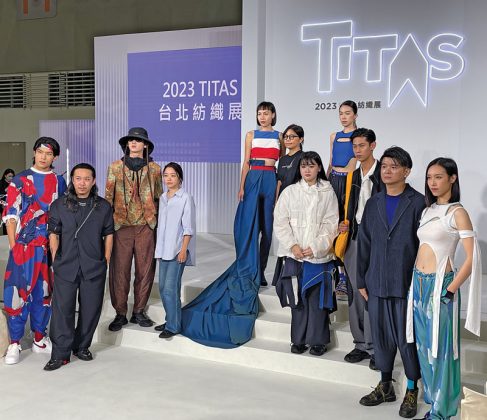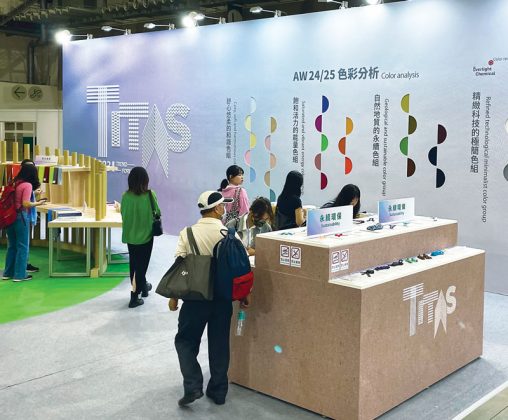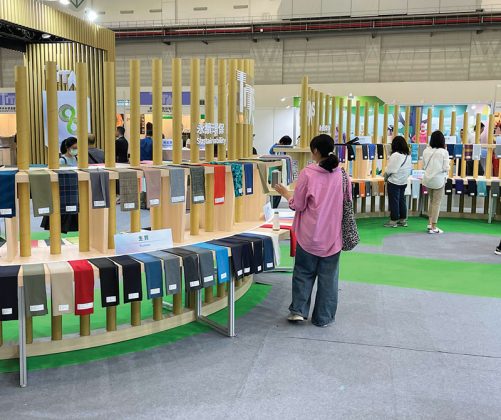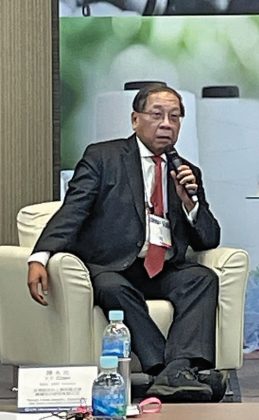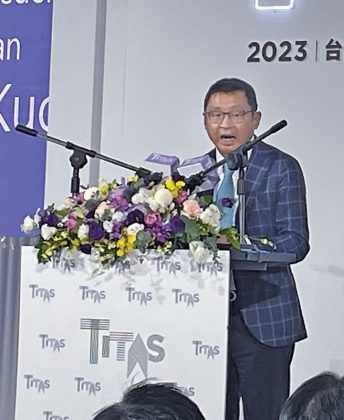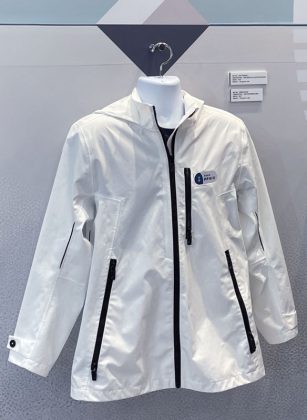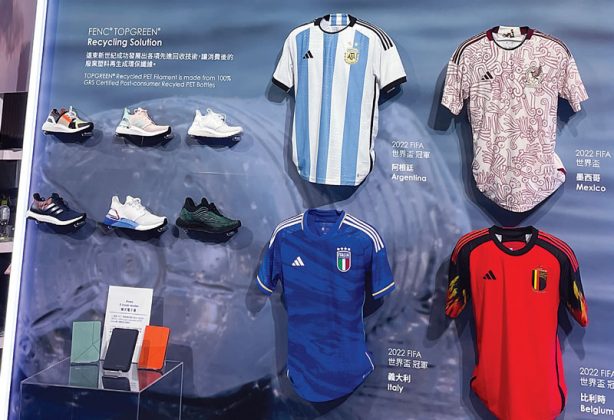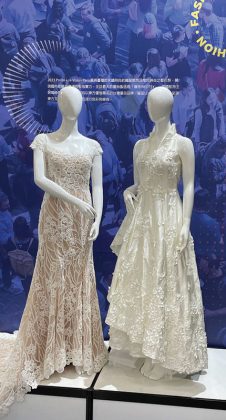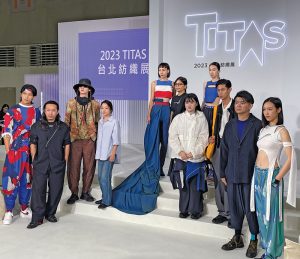
The 27th edition of TITAS — Taipei Innovative Textile Application Show — showcased Taiwan’s innovative and youthful textile industry.
By Jim Kaufmann, Contributing Editor
To begin, here are some interesting statistics and information collected from the 27th Taipei Innovative Textile Application Show (TITAS) held recently in Taipei City, Taiwan:
- More than 35,000 attendees —yes, actual attendance numbers! —from more than 15 different countries during the three-day event.
- A vibrant, colorful and youthful atmosphere throughout the show floor.
- Some 381 international exhibitors from 11 different countries.
- Taiwan’s textile industry ranks first globally in terms of functional and green fabrics resulting in a core theme for this year’s TITAS of “Sustainability, Functional Applications and Intelligent Manufacturing” with virtually every exhibitor booth prominently dis-playing sustainable, recyclable and/or circular products, future concepts and/or even demonstrated results.
- Taiwan’s Vice President Dr. Lai Chingte spoke at the TITAS opening ceremonies emphasizing the textile industry’s importance to Taiwan and Taiwan’s commitment to its textile industry.
- Creativity and innovation were on display pretty much in every direction, including several fashion shows over the show days featuring local designers focusing on what can be done with recycled content, new fabrics and technologies. For example, for the opening ceremony fashion show, the designers involved were given the challenge “to interpret and reflect the fabric’s performance in the garment’s design.”
- Future business opportunities generated during the three days of the show estimated to be in excess of $47 million dollars in value. Not bad for an island country slightly larger in land mass than the state of Maryland.
Organized by the Taiwan Textile Federation (TTF) in partnership with Taiwan’s International Trade Administration of the Ministry of Economic Affairs, TITAS was held at the Nan-gang Exhibition Center. As a first-time visitor, the impressions made were immediate and lasting. TITAS exemplified itself as an active, interesting and truly vibrant show. The TTF and its President Justin Huang are forward thinking, knowledgeable, influential and vibrant. The collective feeling derived from the majority of participants was one of youthfulness and yes, vibrance! The innovative products and technologies on dis-play, not to mention the colors found throughout the exhibitor booths and show floor — yep, also vibrant.
TTF’s Influence And Focus On Technology
TITAS is widely regarded as Asia’s key sourcing platform for textiles and clothing, but this status did not happen overnight. It began years ago when Huang and his colleagues at TTF came to the realization that, “Geopolitics are important and you need to maintain a global perspective to compete.” Huang noted: “Taiwan— with a population of just over 23.5 million people — can never compete with the manpower and efficiencies that other countries in the region possess and we have no free trade agreements with anyone. To compete, we needed to devise a strategy based on technology and innovation to keep all potential customers interested and keep Taiwan ahead of the curve. Once a technology is developed and moves into production, the resulting products will likely be produced in other countries. So, we need to continue developing newer technologies.”
Given the push to advance technologies, Huang and TTF also made a conscious decision to hedge their bets by taking a realistic look at and focusing more on what Taiwan’s textile industry does best. “We don’t have a lot of land to grow cotton, but we do make a lot of synthetic yarns,” Huang said. “So, we devised a strategy to ‘feed the machine’ through encouraging designers, manufacturers and brands to focus on synthetic yarns. Since Taiwan primarily makes synthetic fabrics, it only makes sense to have designers in Taiwan’s schools and mills feed those capabilities they have access to and focus on synthetics and now recycled content in creating performance fashion. Cotton is very important globally, but cotton blends are more important to us.”
The next step was to focus on global and local brands by inviting them to attend TITAS and getting the brands involved in the development process as early as possible. As a result, Taiwan’s textile industry has effectively evolved itself into a leader in textile technology and functionality. “We are able to adapt and change quicker than other countries because of an innovation focus and by playing the long game, or big picture view of industry,” Huang added. “We compete by pushing the envelope and advancing technologies further forward. The designers, brands and retailers want and need versatility and options and we endeavor to provide these options for them. It is difficult to keep this position, but we just try to keep the ideas coming.”
Today, TITAS largely focuses on making available all sectors of Taiwan’s apparel and sportswear markets to all visitors and notably the global brands. “Taiwan is a hub of innovation and functionality, especially in textiles,” stated Philip Wang, assistant sales manager for Freudenberg Performance Materials. “It’s not just the big companies, but also the small ones who do their own developments as well,” a fact that was largely illustrated throughout the show floor.
A few of the many highlights dis-covered at this year’s TITAS included (in no particular order):
- Taiwan Textile Research Institute (TTRI), New Taipei City Taiwan — The research institute, partially funded by its home country, showcased a wide array of textile related research activities developed within the institute primarily for Taiwan’s textile industry.
- A mono-material waterproof and breathable jacket — In an effort to resolve one of the major challenges found in garment recycling, companies including Tokyo-based YKK Group, Singtex Industrial Co. Ltd., Taiwan, and TTRI worked together to develop a functional garment where all components are produced from a singular polymer — in this case polypropylene — for more efficient recycling at the garment’s end of life.
- •TITAS Trend Forum — This display of more than 100 different fabric and component examples filled a section of the exhibit hall and was devoted to showcasing the breadth of technical developments presented throughout TITAS by Taiwan’s participating exhibitors.
- Far Eastern New Century Corp. (FENC), Taipei, Taiwan— The company’s colorful booth presented a clever marketing campaign for its technologies including various consumer products from polymers and yarns made using recycled content “from land,” “from ocean,” and “from air” emphasizing FENC’s broad efforts toward developing recycling solutions.
- Tactile Sensation Analyzer (TSA) — Developed by Germany-based Emtec Co., the TSA can reliably measure and quantify haptic qualities or the “hand” of a fabric surface in an objective manner. “The human hand and eye are no longer reliable enough for this industry to manage comparisons effectively,” said Alexander Gruener, Emtec’s Global Business Development manager. According to Gruener, TSA data can be used for lot-to-lot quality comparisons; to effectively categorize different products; to compare suppliers or competitive products; and potentially to feed accurate data into AI, modeling or simulation programs.
- Pailung Machinery Mill Co. Ltd., Taiwan — showcased further advancements in circular (weft) jacquard knitting machine technologies, including its AlterKnit inverse plating technology in both single and double needlebar machines, as well as a new artificial intelligence (AI)-driven fabric defect detector system that learns as defects happen and are identified.
- The International Cotton Advisory Committee (ICAC), Washington — In a unique move to further promote textiles to young adults, ICAC had students take a picture of themselves inside a large picture frame promoting World Cotton Day and offered 15,000 Taiwan dollars — approximately $465 — to the student who posted the image online and garnered the most likes.
Youthful Atmosphere
Another example of Huang and TTF’s forward thinking was the youthful atmosphere found on the show floor. It was rather evident throughout the duration of the show that a much greater number of participants were under the age of 40 than the number of participants over the age of 40. This presented a very real and striking contrast to the age ratios generally found at U.S.-based textile shows as previously has been discussed in past issues of Textile World. When asked about this comparison, Huang offered that: “We saw the industry getting older years ago, so we went to Taiwan’s universities and learning institutions and helped them create programs to attract more youth into the industry. We wanted to make the industry more appealing to young people by highlighting technology and the recognizability of the brands we cater to. We want the young people to feel engaged, and that helps to keep them here. Textiles do not have negative connotation here in Taiwan and young people continue to relate to the textile industry, technology and the brands. The semi-conductor folks may pay 2.5 times more, but the work is tedious. Textiles is more interesting and continually evolving, which keeps the young people interested. As a result, the majority of people in textiles in Taiwan are younger.” Obviously looking around the show floor, this strategy has been successful!
The recipe for a successful event of almost any kind generally involves a clear focus and purpose, a viable “product” to offer, some solid planning, and a bit of foresight. By all accounts, TITAS is a world-class event certainly worth attending by anyone interested in functional and advanced textile technologies offered in a colorful and most likely vibrant atmosphere.
November/December 2023

